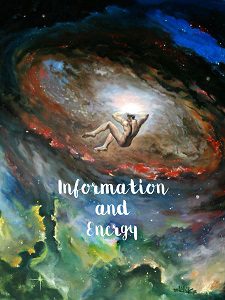“The food (substance) you eat is a concentrated energy and information about the characteristics (of a substance). More simply, it is a thought. You breathe a thought, you drink it, you eat it, you consume it when communicating with other people. Subconsciousness and organism absorb it, just as intellect realizes. You participate in a constant information exchange. You – the information entity – change when absorbing and realizing something. You create your health, your destiny and life, you and your thought (you are a thought yourself) have created all these things.”
Yuri Larichev
“The Slavic Veda. The Hermetic Philosophy in a Readily Understandable Format. The Gospel for Myself.”
“My brain is only a receiver, in the Universe there is a core from which we obtain knowledge, strength and inspiration. I have not penetrated into the secrets of this core, but I know that it exists!”
Nikola Tesla
“Visions of the Future”
“There is no real (absolute) truth, because a real truth must base on a full understanding of Space. But there is no full understanding now and such will never be reached. The science is on the upswing, scientists constantly reject or assert something old and manifest something new. The science changes every decade. Decades doesn’t deny but change it or its content by deleting or adding something. Such processes are endless, because centuries and brain development are also endless.
So, the truth can be only of three types: contingent, temporary and changeable.
Religions regard their dogmata as truth. But can any religion be the truth? There are thousands of religions. They contradict each other, science very often denies them, that’s why religions cannot be considered even as a contingent truth. Political beliefs also more or less disagree. Therefore, we will say the same about them. Philosophical meditations have created worldviews. Due to many disputes over these philosophical meditations, they are perceived as a personal opinion. Some philosophers did not consider anything for their conclusions, except for accurate scientific knowledge. But their conclusions are beneath a contingent truth, since they are not coordinated. Finally, every human understands the truth concept in his/her own way. Many people, many truths. What kind of truth is it!
However, we must decide what is a contingent truth for us. Philosophers, sages and scientists, of course, contribute to the distribution of knowledge about the universe and therefore improve the idea of people about a contingent truth.
A contingent truth can be earth, folk, city, volost, rural, village, family and personal.
The human being acquires personal truth in different ways and considers it to be the best, the most faithful and the fairest. On the average, this is the lowest kind of a contingent truth. It changes with age and human cognition.”
Konstantin Tsiolkovsky
«A contingent truth» 1932
CONTENT
1. Basic words-concepts to meet targets of this research work 6
1.1. TERMS and TERMINOLOGY 6
1.2. ALPHABET 8
1.3. WORD 9
1.4. SIGNS 12
1.5. SENTENCE 14
1.6. CONCEPT 16
1.7. LANGUAGE 19
1.8. SPEECH 21
1.9. WRITING 23
1.10. TEXT 24
1.11. PERCEPTION (MANIFESTATION) 24
2. THOUGHTS are the keystones of “our” World 26
2.1. THOUGHT 26
2.2. JUDGEMENT AND SPECULATION 26
2.3. MEANING 28
2.4. THOUGHTS of the PERSONALITIES of human beings as co-CREATORS of “our” World 29
2.5. THOUGHTS (IDEAS) OF A HIGHER THINKING BEING – the main CREATOR (DEVELOPER) of “our” World 32
2.6. The hypothesis about MEANING of ideas of a HIGHER THINKING BEING 34
3. THINKING 36
3.1. THINKING principles of objects that are parts of a human being 38
3.1.1. THINKING of a human being Body 39
3.1.2. THINKING of the Personality of a human being 42
3.1.3. THINKING of a human being ENTITY 44
3.1.4. VISUALIZATION is the “key” of a human being Personality to CONSCIOUSNESS… 46
3.2. THINKING principles of non-human Creatures 49
3.3. THINKING principles of the non-human Entities 50
4. Where do we get answers to the questions in our heads? 51
4.1. BRAINWORK philosophy 51
4.2. “BALL-A-BALL” hardware-software complex 58
5. INFORMATION 64
5.1. INFORMATION as one’s expressed THOUGHT (IDEA) 64
5.2. TYPES of information 67
5.3. FORMS of information 68
5.4. DATA 69
5.4.1. Types of data 70
5.4.2. Methods of data processing 72
5.5. Information BODY 73
5.6. UNITS OF MEASUREMENT 75
5.6.1. Units of DATA measurement 76
5.6.2. Units of INFORMATION measurement 79
5.7. Information carrier 81
5.8. Information RECORDING 81
5.9. CAPACITY of the information carrier 83
5.10. The “information core” of Nikola Tesla 86
5.11. The main methods to get access to information 88
5.12. Information completeness 88
6. INFORMATION. The basic Principles 91
6.1. One’s Thought creates INFORMATION 91
6.2. INFORMATION is stored at each point of “our” four-dimensional Time and Space… 92
6.3. INFORMATION doesn’t decrease during transfer from one to another one 94
7. The truth can be only of three types: contingent, temporary and changeable 95
8. ENERGY and its connection with INFORMATION 97
9. ENERGY. The basic Rules. 101
10. INFORMATION-ENERGY FIELD 103
10.1. The structure of the INFORMATION-ENERGY FIELD 108
10.2. Humankind and COMPUTER SINGULARITY 114
**********

Enjoy reading it!
